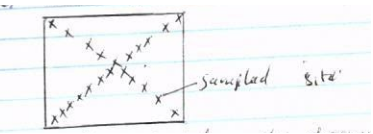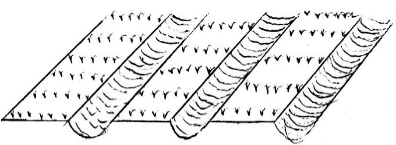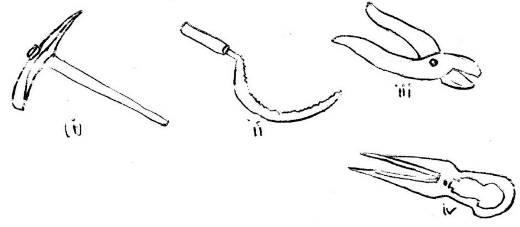AGRICULTURE
FORM 2
MID TERM
TERM 1
INSTRUCTIONS
- This paper consists of 3 sections: Section A, B and C.
- Answer all the questions
SECTION A (30MKS)
- Define the following terms (2mks)
- Entomology
- pomology
- Apiculture
- olericulture
- Outline four aspects of rainfall important in Agriculture (2mks)
- State the four physical agents of weathering (2mks)
- Give four effects of biotic factors in the soil (2mks)
- Distinguish between rip saw and cross-cut saw (1mks)
- For each of the following tools give two examples (2mks)
- file
- scrappers
- chisels
- gauged marking tools
- Describe four conditions necessary for land clearing to take place (2mks)
- State four reasons why burning as a method of land clearing is discouraged. (2mks)
- What is minimum tillage? (1mk)
- Distinguish between a weir and a dam (1mk)
- Give two types of each of the following pipes (1mks)
- Hose pipes
- Metal pipes
- Identify two dairy goats (1mk)
- Give four benefits derived from a camel (2mks)
- Differentiate between macro nutrients and micro-nutrients (1mks)
- Highlight the functions of phosphorus in plants (2mks )
- Give four fertilizers that can be used during planting in crops (2mks)
- List any four methods of harvesting crops (2mks)
- Highlight any two diseases that attack cabbages (1mk)
- List any two insect-pests that attack tomatoes (1mk)
SECTION B (30MKS)
- The diagram below shows a method of soil sampling

- Name the method illustrated in the diagram above.(1mk)
- State 3 precautions taken when collecting the soil for testing using the above method.(3mks)
- Give 4 reasons why soil from the farm is tested.(4mks)
-
- The diagram below shows a practice carried out on various crops on the farm. Study them carefully and answer the questions that follow.
- Identify the farm practice represented by B.(1mk)
- State the importance of the above practice in the following crops
- Maize(1mk)
- Irish potatoes (1mk)
- At what stage of growth should the above practice be carried out in maize. (1mk)
- The diagram below shows a practice carried out on various crops on the farm. Study them carefully and answer the questions that follow.
- The diagram below shows Kale seedling attached by a pest.
- Identify the pest.(1mk)
- What damage does that pest causes to the crop.l(1mk)
- State two methods of controlling the pest.(2mks)
- Study the diagram below and answer the questions that follow
- identify the structure above (1mks)
- State the function of the structure in (a) above (1mks)
- State the importance of activity carried by the structure in (a) above (4mks)
- Study the diagrams below and answer the questions that follow
- Identify tools (i), (ii), (iii), (iv) (4mks)
- Give the use of each of the tools named in (a) above (4mks)
SECTION C(40MKS)
-
- Name and explain the importance of Agriculture in the economy of Kenya (6mks)
- Give practices carried out in minimum tillage (7mks)
- Describe the benefits of minimum tillage ( 7mks)
-
- Highlight the importance of water treatment (4mks)
- Describe four characteristics of a fertile soil (6mks)
- State any four characteristics of nitrogenous fertilizers (6mks)
- Describe four characteristics of a good storage structure (4mks)
MARKING SCHEME
SECTION A (30MKS)
- Define the following terms (2mks)
- Entomology - study of insects and their control
- pomology - growing of fruits
- Apiculture - keeping or rearing of bees.
- olericulture - growing of vegetables
- Outline four aspects of rainfall important in Agriculture (2mks)
- Form of Rainfall
- distribution of rainfall
- reliability of rainfall
- Amount of rainfall
- Intensity of rainfall
- State the four physical agents of weathering (2mks)
- wind
- ice
- water
- temperature
- Give four effects of biotic factors in the soil (2mks)
- Decomposition of organic matter
- encourage aerate
- cause nitrogen fixation
- Act as soil borne pests
- cause soil borne diseases
- Distinguish between rip saw and cross-cut saw (1mks)
- Rip saw cuts along the grains while cross- cut saw cuts along the grains
- Rip saw has more teeth per unit length
- For each of the following tools give two examples (2mks)
- file-
wood file (Rasp)
metal file - scrappers -
hand scrapper
cabinet scrapper
spoke shave - chisels -
Wood chisel
cold chisel - gauged marking tools -
Mortise gauge
marking gauge
- file-
- Describe four conditions necessary for land clearing to take place (2mks)
- when opening up virgin land
- Where a stalk growing crop was previously planted
- where the interval between primary and secondary cultivation is long
- where land was left farrow for a long time
- State four reasons why burning as a method of land clearing is discouraged. (2mks)
- Destruction of organic matter
- Destruction of soil micro-organisms
- Destruction of plant nutrients
- Fire may spread to unintended areas
- What is minimum tillage? (1mk)
- Farm practices aimed at weed control with minimum soil disturbance
- Farm practices aimed at weed control with minimum soil disturbance
- Distinguish between a weir and a dam (1mk)
- Weir is a barrier constructed a stream or river to raise the level of water while a dam is a barrier constructed across of dry river bed, stream or river to hold water back and form a reservoir.
- Weir is a barrier constructed a stream or river to raise the level of water while a dam is a barrier constructed across of dry river bed, stream or river to hold water back and form a reservoir.
- Give two types of each of the following pipes (1mks)
- Hose pipes
- plastic pipes
- rubber pipes
- Metal pipes
- Galvanized iron pipes
- Aluminium pipes
- Hose pipes
- Identify two dairy goats (1mk)
- Toggenburg
- saanen
- British alpine
- Anglo- Nubian
- Jamnapari
- Give four benefits derived from a camel (2mks)
- Milk supply
- meat supply
- skin /hide
- animal power
- fur
- Differentiate between macro nutrients and micro-nutrients (1mks)
- Macro –nutrients are plant elements in large amounts while micro nutrients are elements needed in small amounts
- Macro –nutrients are plant elements in large amounts while micro nutrients are elements needed in small amounts
- Highlight the functions of phosphorus in plants (2mks )
- root development
- stimulate nodule formation in legumes
- needed in flowering, fruits and seed formation
- hastens ripening of fruits
- involve in metabolic processes
- it is part of nucleoproteins
- strengthens plant stems
- Give four fertilizers that can be used during planting in crops (2mks)
- Single upper phosphates (S.S.P)
- Double super phosphates ( D.S.P)
- Tripple super phosphates (T.S.P)
- Diamononium phosphates (D.A.P)
- Mavuno planting
any other N.P.K fertilizer
- List any four methods of harvesting crops (2mks)
- Harvesting with hands( picking)
- Harvesting with hand tools( reaping, digging, )
- Harvesting with machinery(harvesting rigs, mowers, combine,)
- Highlight any two diseases that attack cabbages (1mk)
- Alternaria leaf spot (Black spot, Gray spot) Alternaria brassicae.
- Anthracnose Colletotrichum higginsianum.
- Black rot Xanthomonas campestris.
- Clubroot Plasmodiophora brassicae.
- Damping-off (Wirestem, Head rot) Rhizoctonia solani.
- Powdery mildew Erysiphe cruciferarum.
- Sclerotinia stem rot (White mold) Sclerotinia sclerotiorum.
- List any two insect-pests that attack tomatoes (1mk)
- Aphids.
- Budworm.
- Cutworms.
- Looper caterpillars.
- Two-spotted mite or red spider mite.
- Root-knot nematode.
- Thrips.
- Tomato russet mite or tomato mite.
SECTION B (30MKS)
- The diagram below shows a method of soil sampling

- Name the method illustrated in the diagram above.(1mk)
- diagonal/transverse method
- diagonal/transverse method
- State 3 precautions taken when collecting the soil for testing using the above method.(3mks)
- avoid contamination/use sterilized contained
- avoid sampling soil from unusual sites e.g ant hills
- avoid mixing top soil with sub soil
- Give 4 reasons why soil from the farm is tested.(4mks)
- To determine the nutrients status of the soil
- To determine the soil type/ph of fertilizer to add to the soil / lime to add to the soil
- to determine the type of crop to grow
- may help in diagnosing using low crop yield / mineral deficiency
- Name the method illustrated in the diagram above.(1mk)
-
- The diagram below shows a practice carried out on various crops on the farm. Study them carefully and answer the questions that follow.
- Identify the farm practice represented by B.(1mk)
- earthing up
- earthing up
- State the importance of the above practice in the following crops
- Maize(1mk) - provide support to prevent lodging.
- Irish potatoes (1mk) - improves tuber formation
- At what stage of growth should the above practice be carried out in maize. (1mk)
- During second weeding
- During second weeding
- Identify the farm practice represented by B.(1mk)
- The diagram below shows a practice carried out on various crops on the farm. Study them carefully and answer the questions that follow.
- The diagram below shows Kale seedling attached by a pest.
- Identify the pest.(1mk)
- cut worm
- cut worm
- What damage does that pest causes to the crop.l(1mk)
- Damage crops by cutting the base of the stem of seedling after transplanting
- Damage crops by cutting the base of the stem of seedling after transplanting
- State two methods of controlling the pest.(2mks)
- Mixing appropriate insecticide powder with soil in each hole during transplanting 1mk
- Proper weeding
- Identify the pest.(1mk)
- Study the diagram below and answer the questions that follow
- identify the structure above (1mks)
- Raised cambered bed
- Raised cambered bed
- State the function of the structure in (a) above (1mks)
- Create a deeper soil structure for penetration of roots.
- Create a deeper soil structure for penetration of roots.
- State the importance of activity carried by the structure in (a) above (4mks)
- Reduce cost of cultivation
- control soil erosion
- maintenance of soil structure
- conserve moisture
- prevent root disturbance
- prevent exposure of humus (1x4=4mks)
- identify the structure above (1mks)
- Study the diagrams below and answer the questions that follow
- Identify tools (i), (ii), (iii), (iv) (4mks)
- pick axe
- sickle
- secateurs
- wool shear
- Give the use of each of the tools named in (a) above (4mks)
- pick axe used to break hard soil/ rocks
- sickle used for harvesting or reaping
- secateurs used for harvesting via pruning
- wool shear use to shear sheep
- Identify tools (i), (ii), (iii), (iv) (4mks)
SECTION C(40MKS)
-
- Name and explain the importance of Agriculture in the economy of Kenya (6mks)
- Food supply – Adequate food supply ensures a health population and a weathy nation
- Source of employment – majority of the population is employed either directly or indirectly by agriculture.
- Provision of foreign exchange- This is foreign exchange which results from sale of cash crops e.g coffee
- Source of capital (income) – Farmers sell farm produce and get income.
- Source of Raw materials for industries: These are farm produce sold to factories for processing
- Provision of Market for industrial goods – Finished goods are sold to farmers for use
- Improvement of infrastructure – Roads, markets e.t.c are constructed to ease transport of farm produce (naming ½ mk- explanation 1mk – Any acceptable explanation = 6mks)
- Give practices carried out in minimum tillage (7mks)
- Mulching establishment of cover crop
- crop rotation, basin flooding ,
- timely cultivation
- timely planting use of herbicides
- slashing
- uprooting weeds
- Describe the benefits of minimum tillage ( 7mks)
- Reduce cost of cultivation
- control soil erosion
- maintenance of soil structure
- conserve moisture
- prevent root disturbance
- prevent exposure of humus
- Name and explain the importance of Agriculture in the economy of Kenya (6mks)
-
- Highlight the importance of water treatment (4mks)
- Kill diseases causing micro-organisms
- Remove chemical impurities
- remove bad smell and bad taste
- remove sediments of solid particles 1x4 = 4mks
- Describe four characteristics of a fertile soil (6mks)
- Good depth
- proper drainage
- good water holding capacity
- adequate nutrient supply
- correct soil PH
- Free from excessive infestation of soil borne pests and diseases
- State any four characteristics of nitrogenous fertilizers (6mks)
- highly hygroscopic
- highly soluble in water
- short residual effect (short lived)
- easily leached
- have a scorching (burning ) effect
- highly corrosive
- highly volatile 1x4 =4mks
- Describe four characteristics of a good storage structure (4mks)
- it should be easy to clean .
- it should provide protection from animal etc.
- it should be water proof and moisture proof.
- Good aeration
- Easy to fumigate and inspect
- Highlight the importance of water treatment (4mks)
Download Agriculture Questions and Answers - Form 2 Term 1 Mid Term Exams.
Tap Here to Download for 50/-
Get on WhatsApp for 50/-
Why download?
- ✔ To read offline at any time.
- ✔ To Print at your convenience
- ✔ Share Easily with Friends / Students





